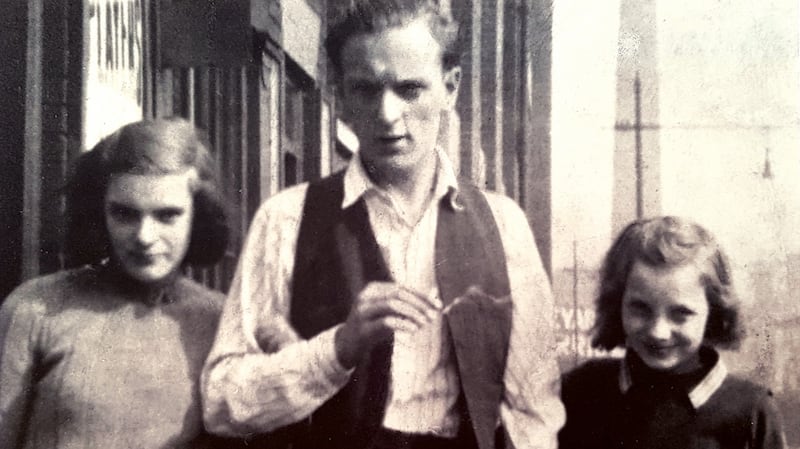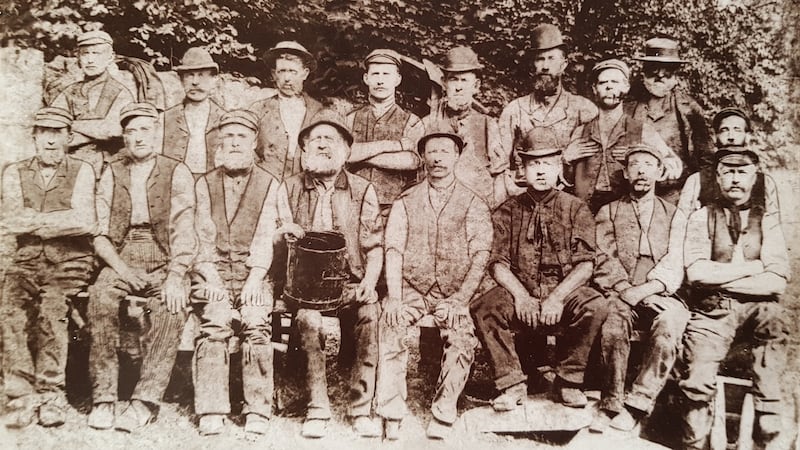A Proper Person to be Detained by Catherine Czerkawska is the story of a murder and its aftermath.
On Christmas night in 1881, John Manley, a poor son of Irish immigrants living in the slums of Leeds, was fatally stabbed in a drunken quarrel. The frightened murderer went on the run, knowing that capture could see him hang.
A few generations later, author Catherine Czerkawska begins to tease out the truth behind her great-great-uncle’s tragic death. But she uncovers far more than she bargained for.
In a personal family story that takes us from Ireland to the industrial heartlands of England and Scotland, from the 19th century to the 20th, Catherine gives voice to people often maligned by society and silenced by history – immigrants, women, the working classes.
She unearths a tale of injustice and poverty, hope and resilience, and she is both angered and touched by what she finds. Catherine is driven to keep digging, to get to the very heart of life – and death – in the not-so-distant past.

Extract
Swathes of middle-class writers, Victorian and later, tried and failed to illuminate the terrible conditions in which vast numbers of people were living and working, because those most badly affected had no voice of their own.
How could they be otherwise? They could neither read nor write. The voices they once had, the Irish, the Highland Scots, the Dales people who, like my grandfather’s antecedents, had fled terrible conditions in the lead mines of Swaledale, economic migrants all of them, had effectively been silenced. The languages and dialects they spoke were denigrated or proscribed.
The Gaelic languages in particular were so disparaged that they could, in all seriousness, be hated and mocked by Friedrich Engels, a native German speaker, when they were heard on the streets of Manchester. His English friends would have agreed with him. The songs these people sang and the stories they told were mocked. The traditions they held dear were dismissed as superstitious nonsense. These people were scorned simply for being what they were. Those who found their voices were too often castigated for speaking out.
For such people, in later years, it was almost impossible to describe the times they had known and most of them didn’t even try, although they did still sing the songs and tell the tales, nostalgic for the country they had lost, while acknowledging the impossibility, for them at least, of ever going back. For too many years, Ireland’s greatest export was people, although this looks like a trend that is set to be reversed.

The true plight of working-class women in particular in industrial Britain is hardly ever evoked in any meaningful way. Henry Mayhew’s verbatim accounts are the closest I have ever come to hearing the voice of the industrial poor, men and women, picturing and hearing them as I read, although when he is writing about the Irish, sympathetic as he is, even he transcribes their words into a kind of fake brogue.
Elizabeth Gaskell’s factory workers, as fine a writer as she is, seem like minor characters beside the true heroes and heroines. Bessy Higgins is as beautifully drawn and sympathetic a portrayal of a young working-class woman as you will find, but even so, she is there mainly to teach tolerance to Margaret Hale. Such characters are seldom permitted agency, seldom allowed to be defiant or angry on their own behalf, as we perceive that Elizabeth Manley – mad or not – seems to have been both defiant and deeply, viscerally angry about her fate.
There have been stories about upper-class women in Victorian Britain wrongly consigned to insane asylums, brave stories tackling domestic abuse, such as Wilkie Collins’s The Woman in White and Anne Brontë’s The Tenant of Wildfell Hall. But where are the stories about the Elizabeths of this world: the young women whose lives seemed to be worth less than nothing in the grand scheme of things?
It is too easy to see her only as a victim. She had some happy times. She would have felt joy and sorrow, love as well as pain. She had her hopes for a better future. We know she did, because there would have been little reason except the hope of something better and more fulfilling to take her all the way to Glasgow.
We know something of the songs she sang, the stories she told and the games she played. She would have skipped in the street as I once did. Everyone “played out” in all weathers, because the houses were too small to permit anything else. She too may have chanted about the girl of the golden city and giggled about the tom cat with the pancake stuck to its bum. Her mother would have taught her how to bake bread, how to sew, how to wash clothes.
Did Mary Manley senior speak and sing in the Irish language? It’s quite possible that she did. She came from an area where the language was spoken. The decline had begun before the famine, but it was still widely, albeit often privately, spoken about. Sometimes people wouldn’t admit to knowing it, since they had been made to feel ashamed of it. For those contemplating migration, English was essential. Did Elizabeth speak, as I did, with the dialect of the city where she was born, or had she picked up at least some of her words and ways of speaking from her Irish parents? Did she learn how to use yellow “donkey stone”, handed out by the rag and bone man in exchange for a few rags, to craft careful and beautiful designs on the steps of the house in Brussels Street, as my grandmother Nora did, desperately making silk purses out of sows’ ears?
Even factual accounts from those times are either disapproving or remote. Or – like Engels’s manifesto – powerful but prejudiced. The truth is that the reality of what it must have been like for these people constantly slides away from us, just as it slid away from me, as I was writing this.
Ultimately, I came to the conclusion that the reason for the almost constant knot of anguish I felt somewhere inside me, as I tried to write this story, perhaps most of all as I tried to write and come to terms with Elizabeth’s story, was the fear that even though I was writing something very close to home, there was no way of getting to the heart of it.
Every once in a while, I dream about 32 Whitehall Road, the house in Leeds where I spent the first seven years of my life. Sometimes I’m outside, in a different part of the city, looking for the house, knowing that it is still there, if only I can find it. Buses are running but I have forgotten how to get there, forgotten which buses to take. The city has changed beyond recognition, but the house is still there, only I have lost my way.
Sometimes the house is as I remember it: warm, a little dusty, with a fire that smokes when the wind is blowing in the wrong direction. I can see the steps at the front door that my nana carefully decorated with donkey stone and the curtain to keep out the draughts and the Anaglypta dado. It is full of heavy furniture and the scent of baking, just as it was then. Sometimes it is empty and distressing, but occasionally in the dream, it is not derelict. It is an ancient house, richly ornamented, the stones older than I ever realised, tunnelling deep under the bedrock of the city, and those are the strangest dreams of all.
We must have gone back on a visit to Leeds when the house was derelict, before it was demolished, before the new millennium, when the nice old pub next door was demolished too, and the land was absorbed by Petty’s, the big printing company that had grown and surrounded it as efficiently as any parasitic plant. Perhaps it was when I was travelling to Leeds University for my postgraduate course. I don’t remember the time, but I do remember that peculiar, unmistakable smell of an abandoned building: lathe and plaster, mould, mice, the few remaining fragments of the rich and complicated lives that we lived there, hanging like shreds of wallpaper...
I find myself going down into the cellars, although I seldom saw them in real life. The uneven stone cellar steps were dangerous, and I wasn’t allowed to go down there, except once in a while, when my father or my grandad was fetching coal, and I ventured cautiously in their wake, before being sent back up to the living kitchen. It was dirty down there, full of coal dust and cobwebs, and the cellars seemed to stretch on and on, as perhaps they did. These were very old houses, in an old part of the city. I don’t know if anyone had ever lived in these cellars as they had once lived in the cellars over the river, in Brussels Street and Off Street and Brick Street, as some of my forebears themselves had almost certainly done.
Maybe the house, with its adjacent buildings, had been part of the inn next door, fortuitously situated on one of the main routes into the city, as the Gallowgate had once been a main road into Glasgow. There had been springs too, like at Spoutmouth, until the clutter of the Industrial Revolution, the mills, the factories and forges, the roads and bridges and railways, slowly but surely choked out every hint of green.
In every version of the recurring dream, the cellar is not what it was, a dark, dangerous, cobweb-ridden place. The cellar is a treasure trove, full of long-buried items, collections of precious things, gleaming, built up over time, layers and layers of artefacts. The cellar goes on and on, beneath the city. And in every dream, I find myself exclaiming over my finds and wondering, “How could I not know about these things when I lived here for seven years?” But it is only a dream, and it comes very seldom, perhaps because I find it at once tantalising and distressing. I want to stay, I long for the dream to go on and on.
The truth is that the house is gone, demolished to make way for a factory that is partly gone itself. Sometimes the house is as it was on that last visit, derelict, with only the cellar sheltering hidden treasures. Rarely, I open the door and exclaim, “But it isn’t so bad after all. You could make something of this! It’s all right. You could do something with this! You could even live here.”
A little while ago, the dream came back to me again, and this time, there was no need to go down into the cellars. The house itself was warm again, full of life and light, full of people who had once been loved and had loved in return, people who had suffered terribly, who may have behaved badly, but who had also laughed and sung and survived, who were still loved and remembered.
That may have been the most enticing and distressing dream of all. Waking, it occurred to me that all of these things had been heading for the surface, like moles casting up fresh earth. I am flesh of the flesh of these lowly, I am bone of their bone. The time had come to take these things out into the light, and examine them at last.
This is an extract from A Proper Person to be Detained by Catherine Czerkawska, published by Saraband, at £9.99. Ian Duhig reviewed it in The Irish Times on July 27th











